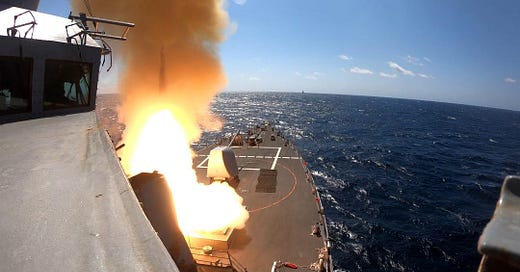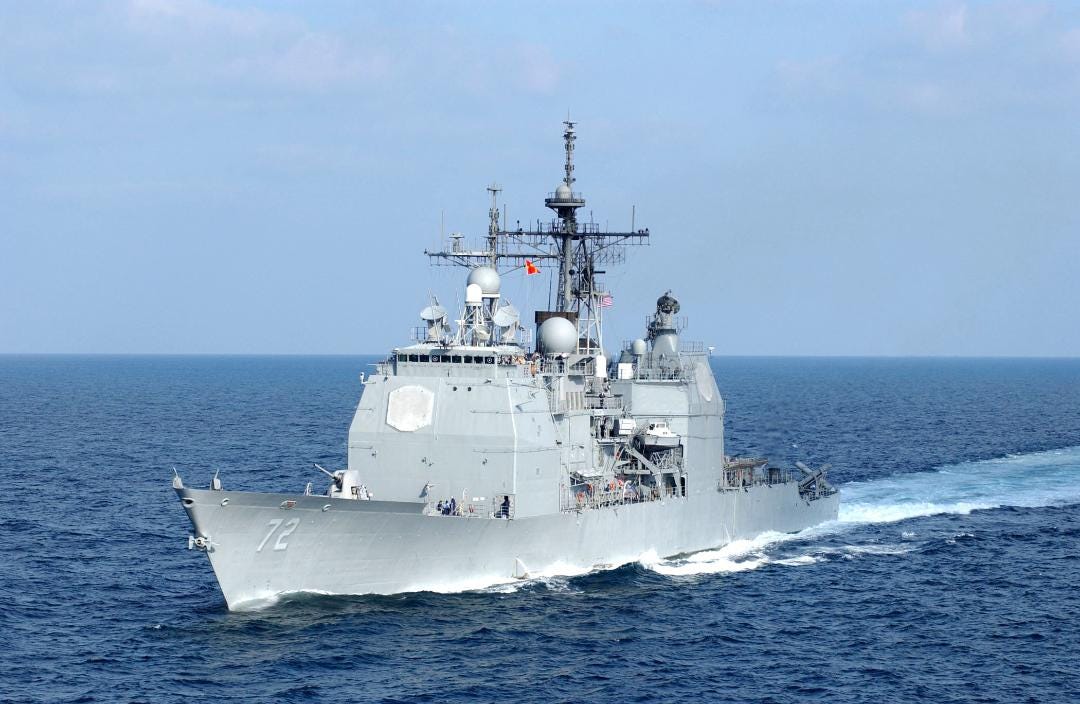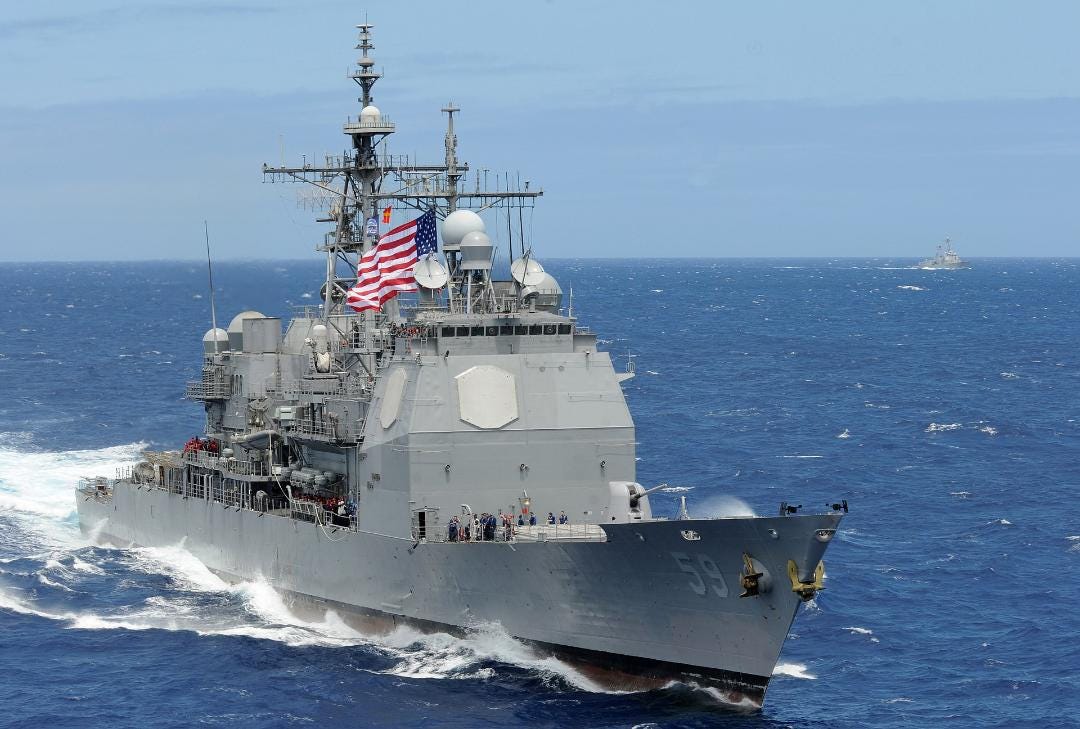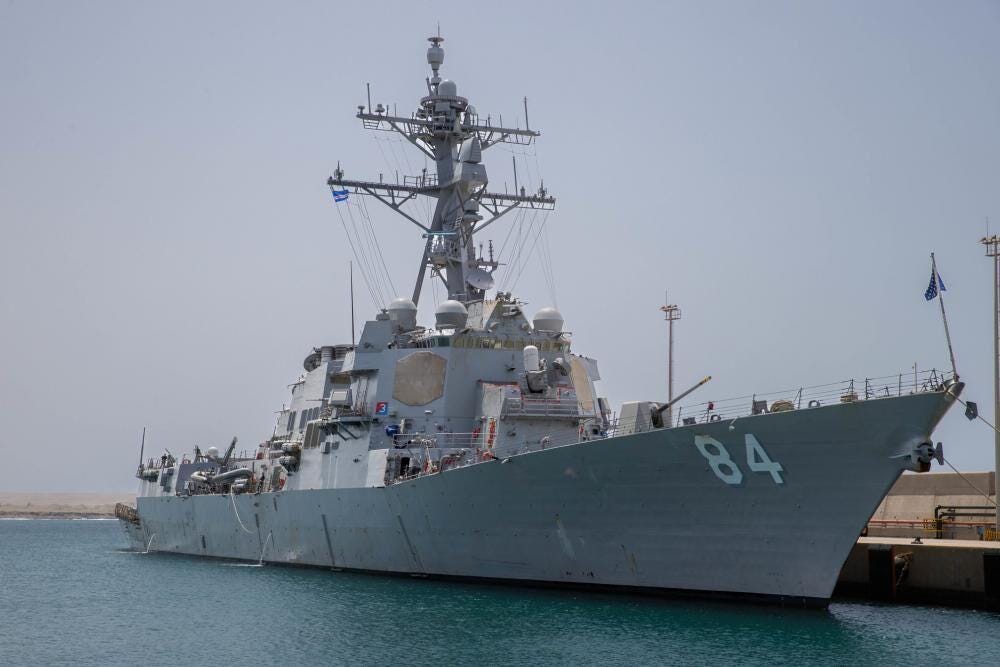All human institutions lack perfection. What defines the most effective institutions is not just if they have the fewer imperfections than their peers, but if the balance of those imperfections contain in them positive aspects.
In the vast human institution that is the US military and the industries that support it, what could be its crown jewel?
I’ll give you a hint; “Build a Little, Test a Little, Learn a Lot.”
To kick off the week right, returning here for a guest post, Bryan McGrath.
Bryan, over to you.
“This conjunction of an immense military establishment and a large arms industry is new in the American experience. The total influence—economic, political, even spiritual—is felt in every city, every statehouse, every office of the federal government. We recognize the imperative need for this development. Yet we must not fail to comprehend its grave implications. Our toil, resources and livelihood are all involved; so is the very structure of our society. In the councils of government, we must guard against the acquisition of unwarranted influence, whether sought or unsought, by the military–industrial complex. The potential for the disastrous rise of misplaced power exists and will persist.”
(President Dwight D. Eisenhower in his January 17, 1961 farewell address).
Introduction
President Eisenhower’s quote above, issued on the eve of his transfer of office to a man who claimed that the United States had fallen behind the Soviet Union in a “missile gap”, has been paraphrased countless times since, usually employing the mischievous and irresponsible shorthand of “beware the military-industrial complex”. This shorthand—affixed conveniently to the words of America’s greatest military hero since U.S. Grant—has provided myriad commentators with the opportunity to stoke fear and anxiety in the mere existence of a nexus between American industrial might and military power, usually as a means to diminish the resources necessary to maintain it. Even a cursory reading of the quote reveals a far more limited (and reasonable) warning, that we must “…guard against the acquisition of unwarranted influence, whether sought or unsought, by the military-industrial complex.” The value of such a nexus and the healthy interaction within it and between it and the citizenry it serves, is not questioned; he refers to it as an “imperative”. One can easily contemplate an outgoing President issuing similar warnings about the unwarranted influence of labor unions, the news media (and its younger sibling, social media), the entertainment industry, or “big business” in general. It seems, however, that only the military-industrial complex has earned the distinction of having its very existence worthy of questioning. I rise in opposition to this cartoonish rendering of the military-industrial complex, and I come not to bury the military-industrial complex but to praise it.
I will do so using the instrument of my personal history, and I will limit its application to what I know best and what I care about most, which is the military-industrial complex that supports the U.S. Navy Surface Force. There are among my readers, people like me who could pipe up with parallel arguments using Army Air Defense Artillery, Marine Corps connectors, or the Joint Strike Fighter as the means to advance the same notion. I leave those subjects to them.
Dateline: The Red Sea, Today
The gist of my argument is this: the combat performance of U.S. Navy destroyers in the Red Sea against a variety of weapons employed by the Houthis from Yemen stands as a monument to decades of brilliance, hard work, and dedication across generations of naval officers, government civilians, industry executives, talented engineers and technologists, assembly line workers, and shipbuilders. THIS—is the military-industrial complex, and it works.
Since shortly after the deadly Hamas terror attack on Israel in October 2023, the Houthi rebels in Yemen have—with the support and resources of their patrons in Iran—attempted at the very least, to disrupt shipping traveling through the Red Sea (well, except for Chinese, Russian, and Iranian shipping, but I digress), and at most—to create a wider, regional conflict. While they have seen success in the former, they have been unsuccessful in the latter. This is in no small measure due to the presence and actions of a group of U.S. Navy ships operating in concert with allied warships. I leave to residents of those countries, throaty defenses of their own military-industrial complexes, but we cannot ignore the contributions they make.
The American ships have neutralized threats launched against both Red Sea shipping and the State of Israel. The threats include armed and unarmed, unmanned aerial vehicles (UAV), anti-ship cruise missiles (ASCM), land-attack cruise missiles (LACM), and anti-ship ballistic missiles (ASBM). The ships have employed a number of weapons in this effort, including surface-to-air-missiles (SAM), naval gunnery, and self-defense systems. Additionally, those ships have employed offensive weapons to target Houthi capabilities ashore. A significant part of this effort has been undertaken by the carrier USS EISENHOWER (CVN 69) and its embarked air wing. The aircraft carrier and carrier airwing building elements of the military-industrial complex are also worthy of high praise, but that is for another day.
What we see on display in the Red Sea is the zenith of naval combat performance. Every day, incredibly well-constructed ships employing the world’s most sophisticated and dependable weapons and sensors, operated by well-trained and initiative-taking Sailors, act with restrained violence to stifle regional conflict and promote freedom of the seas. None of this—and I mean NONE of this—is an accident. It is the result of the proper functioning of the military-industrial complex, and it is the envy of the world. Having commanded a U.S. Navy destroyer myself in younger days (2004-2006), I am pleased to see the same kind of confident employment of the weapons systems that I would have expected of my crew a decade and a half ago, although MY weapon system—on a then three year old destroyer—has been modified and upgraded several times since to achieve the same level of technological acuity that the destroyers in the Red Sea have today. This again is a result of the proper functioning of the military-industrial complex.
Four Decades of Progress
To demonstrate the steady march of capability across the decades, I will provide the reader with a history of the U.S. Navy Surface Force as seen through my eyes and my career. This might be a little torturous for some readers, and more self-indulgent than others may prefer. If you want to skip the history lesson, here is the take-away: each time I moved from one ship to another, the capabilities of that new ship were demonstrably greater than the one I left behind, and in the time since I retired, that capability evolution has proceeded.
In the summer of 1987, I reported to my first ship, the USS MCCANDLESS (FF 1084), a Knox class frigate. We had an air search radar, a surface search radar, a gun-fire control radar, a bow-mounted sonar, a towed array active sonar, a towed array passive sonar, a five-inch gun, an electronic warfare system (passive), an underwater battery fire control system, an over-the-side torpedo battery, a rocket thrown torpedo, and an anti-ship cruise missile. None of these systems were integrated with each other. To the extent that any real integration occurred, it was between the ears of the Tactical Action Officer (TAO) and the Commanding Officer (CO). If everyone on watch really tried hard and clicked his heels together three times, we could do one thing at a time passably well. We did not have a “combat system”, we were not networked with other ships, at least not in any sense that we use the word today. We coordinated with voice, and we were on our own. We looked across the pier at the future—the TICONDEROGA class cruisers with the AEGIS Weapon System and the SPY 1A Radar—and we were downright jealous. I think that by the time I arrived on the Norfolk waterfront that summer, TICONDEROGA and YORKTOWN were the only two there, although soon thereafter USS THOMAS S. GATES (CG 51) arrived.
So jealous was I that once I earned the requisite qualifications—and upon learning that the frigate I was attached to would be joining the since dis-established “Naval Reserve Force”—I sought from and received (from a forward thinking CO) clearance to transfer to one of those sexy AEGIS Cruisers (USS THOMAS S. GATES (CG 51)), which I did in the summer of 1990. A friend of mine had already done so, and he helped smooth the way. That experience has already been immortalized in print, and you can read about it here. AEGIS was a proper combat system. Well, sort of. It was a proper combat system in one mission area, anti-air warfare. By that, I mean that the command-and-control system governed a radar and produced tracks that were shared with a weapons control system driving a missile launching system. This was a great leap forward and was designed to provide capability against raids of Soviet bombers and submarine launched cruise missiles. Another substantial improvement was to finally be admitted to the Link-11 world, which enabled a group of ships to share information about their common operating environment. The five-inch guns were sorta integrated, but the two self-defense gatling guns were not, nor were most of the other weapons and sensors. Our Harpoon anti-ship system was the same one I had on the frigate, but overall, we were cutting edge.
In 1994, I returned to sea on another AEGIS cruiser, the USS VELLA GULF (CG 72). VELLA GULF was BRAND SPANKING NEW, and I spent three years on her. The capability distance between her and THOMAS S. GATES was eye-watering. We had 122 vertical launch cells, rather than a pair of two-rail guided missile launchers. Our guns were better integrated. We had Tomahawk Land Attack Missiles (TLAM), but they were essentially stand-alone. Our electronic warfare system was better than my first ship, but it was still pretty much stand-alone. Along the way, we integrated Link 16, which was a mess, until it was not anymore. And we had a major upgrade to the radar, with the SPY-1B.
In 1999, I headed off to San Diego and USS PRINCETON (CG 59), another cruiser. She was halfway through a long overhaul when I got there as XO, and when we left, we were even more capable than VELLA GULF was. We had a better computer program (AEGIS and Link 16 fought with each other less), our TLAM and Harpoon were better integrated. The Electronic Warfare system was more sophisticated, but still not fully integrated, and there continued to be little interest in integrating the anti-submarine warfare systems (sonars, torpedoes, etc.). Shortly after I left, PRINCETON was due to install Cooperative Engagement Capability (CEC), a modality for networking SPY radar (and electronic warfare) information across a group of ships.
In 2004, I arrived at my first AEGIS destroyer USS BULKELEY (DDG 84) as CO, another three-year-old ship (new ship smell included) that was heading into a yard period that would install a brand-new AEGIS program that included fully integrated CEC. TLAM was integrated, but somehow the newer destroyers lost their Harpoon missiles, so I had no organic method of killing a ship outside of the radar horizon (something that has been fixed). I got to employ another new (to me) radar, the SPY-1D, and my electronic warfare system was better than I had before, but it was still not fully integrated. Again, my anti-submarine warfare system was stand-alone. I left this ship in the summer of 2006, and retired in the spring of 2008.
Since I left sea duty, the surface force has continued to improve the AEGIS combat system, not only giving it more capability against increasingly lethal threats, but it has necked-down the number of combat system variations, helping with enablers like spare parts and training. The ships employ more sophisticated variants of the Tomahawk missile that give it the ability to target land sites and moving ships at sea, as well as the proto-hypersonic SM-6 missile that also is useful against both target sets. Link 16 is ubiquitous, as is CEC. The Navy has fielded a new radar (the SPY 6) on the latest Flight III Destroyer, and it has begun to backfit a sophisticated new Electronic Warfare system on newer destroyers. The bottom line of this long dissertation is that the ships in the Red Sea today are by far more capable than my BRAND-NEW destroyer was when I departed in 2006. On purpose and by design.
How Did We Get to This Point?
Since I have already stated that the level of technical and tactical sophistication in today’s fleet is not an accident, how did it come about?
You guessed it. The much-maligned military-industrial complex has chugged along properly overseen and resourced, responding to validated fleet requirements, and integrating technological wizardry with which this nation appears well-endowed.
More to the point, there is a virtuous relationship between the Navy and the defense industry (a.k.a. a military-industrial complex). Sometimes, the fleet discerns an operational need, and that creates a requirement that demands an industry solution. Sometimes, industry discerns a capability or technology that drives a change in operational concepts that the fleet then determines to be useful in its objectives. It advocates for that operational need, and a requirement is realized that technology can quickly be applied to. And so it goes.
At the heart of this virtuous cycle is constant communication between customer and provider. Here is what the Cassandras inveighing against the military-industrial complex often point to as one of the locations of “unwarranted influence”, but they have it wrong. The goodness we see in today’s shipboard operations is a direct result of this communication. Officers in the fleet and those coming to the Pentagon from the fleet have clever ideas and a solid awareness of fleet needs. They then help steward requirements through the system and help allocate resources toward useful ends. Contrary to what some in the Pentagon seem to think, talking with industry representatives about the kinds of things that the Navy needs is not going to trip a contract protest. It is however, one of the most effective ways for a Navy requirements officer to influence how industry partners spend their internal investment money.
I am a defense consultant, and I count among my clients the Commander of Naval Surface Forces and the Pentagon-based Director of Surface Warfare Programs. These flag officers have been my clients for a long time, and in that time, I have had the opportunity to watch incredibly talented people come to work on these staffs. Unlike what some experience in sea-going jobs, many come to be frustrated by the rate of change and the opportunity for progress in the programs they manage. A two or three-year tour in surface warfare requirements can be considered a real success if you take two steps forward and 1.9 steps back.
Over time though, that .1 steps forward by consecutive requirements officers makes a difference, and over four decades, that means the difference between an AEGIS Cruiser of limited anti-air warfare integration, no land attack capability, a standalone anti-ship missile system, and a 1960’s era data link, to a modern destroyer serving in the Red Sea today, with multiple options for servicing land and sea targets, an unparalleled level of combat system integration (but with more work to be done), sophisticated electronic warfare and countermeasure systems, and real-time theater-wide networking. If one were to do the forensics on these capability improvements, they almost certainly were born of a conversation between someone wearing a Navy uniform and someone from industry, one of whom has a promising idea and the other of whom has the desire to implement it. This is the essence of the military-industrial complex, and it works.
One additional thought. Over the years, I have watched an interesting cycle repeat itself. CAPT Boffamotta (name changed to protect the innocent) has had a few Pentagon requirements tours, and in the process, he has adopted a judo-stance approach to interacting with people in the defense industry, people he has come to believe—in no small measure because others around him believe it—are actively seeking to fleece the Navy. When it comes time to retire, he looks around and realizes that the non-defense civilian world does not precisely value the skills and talents he has gained in his career. Eventually, he pursues a job in the defense industry, figuring he can do honorable work on that side of the fence and help inject much-needed integrity into the system. Do you know what retired Captain Boffamotta finds once hired? He finds that the people on the other side of the fence are utterly determined to provide the Navy with the best capability that the Navy’s money can buy. He finds that they ardently wish the Navy had more money, because they are cooking up ideas that will knock the Navy’s socks off. When he sits in internal program reviews, he finds the profit margins are not only lower than he thought, but that they are reasonable. He comes to realize that the Navy is often a difficult, if not a terrible customer, and he recognizes some of his previous active-duty behaviors in action. He then becomes an effective part of the communication between industry and the Navy. This is the military-industrial complex, and it works.
Where Does Congress Fit?
It never ceases to amaze me when I hear people talk about the defense budget as if there were a certain number of dollars that would provide an optimal level of national defense. In this fantasy world, incredibly smart analysts crunch numbers, the Department of Defense creates a bill for the Office of Management and Budget, and this bill is then presented to the Congress—who pays it unflinchingly because of the obvious wisdom of the thinking that went into it, not to mention the unquestioned non-parochialism of the legislators involved.
This is not how things are done. The inefficiency, the pork, the parochialism, the horse trading, the compromise—these are not bugs. This is the system. And it is this system that drives defense spending. Because there are no “point solutions”, there will always be inefficiency. That inefficiency gets papered over by additional resources. Lather, rinse, repeat.
What often tends to be attributed to the military-industrial complex as undue influence is more often than not, an imperfect method of Congress allocating resources among contending claimants. After mucking around in this world for a while, I have come to conclude that the closer we come to a perfect system of resource allocation, the farther away from representative democracy we will be. It is not pretty, but it is the military-industrial (Congressional) complex, and it works.
Conclusion
Have there been abuses in the system? Are cost overruns endemic? Are new capabilities delayed in reaching the fleet to an unsatisfactory degree? Of course. One would have to be immune to the world around them to think otherwise. Is this a sign of an evil or corrupt system, one of which Americans ought to “beware”? No. These are the signs of an imperfect system run by imperfect humans attempting to define the indefinite—and that is, how much is enough? Our legal system provides for serious legal penalties in the event of actual “unwarranted influence”, and there are enough would-be whistleblowers out there to ensure the effective implementation of these statutes.
As was pointed out in a recent superb article on the Eisenhower’s farewell speech, the United States was spending nearly three times as much on defense (as a function of GDP) when Eisenhower made his speech, and nearly two-thirds of all federal spending was on defense. His words of caution represented the wisdom of a prudent man. We would do well to mix some of the caution we take with the wisdom presented earlier in the quotation, when Eisenhower stated, “We recognize the imperative need for this development.” That is, if there were not a military-industrial complex, we would have to invent one.
Bryan McGrath is the Managing Director of The FerryBridge Group LLC, a defense consultancy. The opinions expressed here are his.












“we must guard against the acquisition of unwarranted influence, whether sought or unsought, by the military–industrial complex”
- The money shot. We see it at every sportsball flyover.
After reading Bryan’s admiration and cumulative results of the MIC here a few of my immediate thoughts: Using the example of the current Red Sea operations as a metric for MIC success is a bit disingenuous. Our current Navy doctrine is a result of an evolutionary process that is based on decades of sea duty and exercises and fleet battle experiments that is boiled down into DOCTRINE/OPORDS/ROE/BATTLE ORDERS. We are using our navy in an effort to clear the sea lines of commerce (which is absolutely our duty and responsibility as a Naval power) while putting our naval doctrine and individual tactics to practical use as designed. We have been attacking Islamic pirates literally since the 1800’s. While fighting the sand people of the straits of Barbara Mandrell and winning, we are potentially leading ourselves down the dangerous path of hubris while patting ourselves on the back as to our self declared metrics of success. Caution, We are using up valuable stores from our big Navy magazine. A magazine that everyone knows is over priced, under funded, under supplied yet critically needed for the SURVIVAL of our Navy ergo our republic. We won’t truly be able to judge maritime quality and success until we read the after actions of the coming sea battles against the Chinese.
Regarding the technical side of the argument, evolution of naval systems is more pennywise than the pound foolish revolution of systems. Like Bryan, I was on an FF in the late 80’s where we slowly introduced JOTS (very early precursor to JMCIS and later GCCS) and a world of wonder opened up with tactical pictures being shared. I don’t ascribe this evolution necessarily to the MIC so much as the natural evolution of naval warfare. The MIC is simply the means to achieve it. Or that should have been the path. In later years on board a CVN while in the yards, I would see NAVAIR contractors invade my CDC and install equipment that literally no one knew how to operate or even understand what its purpose was. A NAVAIR civil servant would hand over a bunch of technical information and we would get a few contractors to ride along on our first underway to test the system/equipment and “train” the operators and maintenance techs. Was the equipment needed? I don’t know. Did the equipment improve our fighting ability? In my opinion, no. We had to redirect training a new crew on a new system that negated our previous experience operating an “older” system. The new system lost all the experience and everyone was now a new learner on an immature combat system. The old “give it to them and let them figure it out” seemed the order of the day and the way to force success. Is the fault of the “MIC” I don’t know. I suspect that the equipment was sold to a room of admirals by a group of retired admirals as very necessary “across the naval enterprise” and well the next thing we know, we are having it installed. Some worked (GCCS) some didn’t (SDC). The gear came aboard before the “integration cut off date”. Funny thing is the new equipment and the manpower requirements and actual new transfers of Sailors never coincided. That’s another story.
I saw the same thing happen while I was in my twilight years at a naval technical training command. I watched as we were sold a bundle of training aids as a way to induce faster learning. Our ISIC swallowed the pitch and the training aids were forced into the curriculum. Unsupported and unable to perform, the navy instructors were able to make the training aids limp along for a DECADE until a new set of training aids were developed. The result? The manpower and instruction hour reductions sold to the navy by the MIC as an efficiency actually led to fewer instructors (course ratios and time to train = fewer instructors) more training time and lost training days and fewer training stations due to broken and unsupported and unsustainable equipment. Let’s not even talk about NMCI or “not mission capable internet”. Who can forget the doctor evil meme of the day about NMCI?
Have there been successes? Sure. Have there been colossal failures? Absolutely.
Is the MIC necessary for our evolution as a military? Yes.
I can’t bring myself however to praise the MIC as angelic where the board of directors of these companies are made in the noble mode of Lancelot. I have been under the dress of the fat lady (worked for LM for a couple of years) and have seen the view. Let’s not gloss over the revolving door and it’s effects as Flag officers move into the MIC as members of the board and company / corporate officers.
Bryan,
This is an excellent, well written and well thought out piece. I'm probably 90% +/- in agreement with you.
Where I differ has to do with degrees and with my own experience.
I've never so much as set foot in a shipyard or dealt with shipbuilding. I cannot speak to how accurate your depiction of that process is, so I accept your assessment as true from your perspective.
I did spend my first 15 years after the Marine Corps as (mostly) a contractor in the Intelligence Community, which is, for the most part, served by the same defense - industrial complex.
And what I found there, almost without exception, was that former military officers and senior civilians working as junior and senior executives in those defense firms were more than capable of rationalizing nearly any action if it drove profits and their personal stock holdings.
They smelled 'wealth', and they wanted more. It wasn't enough to be successful. They wanted to be rich. And as a result, they would sell literally anything to the government, for whatever price they could get away with.
This was, to be certain, during the heyday of the wars in Iraq and Afghanistan and the largesse of GWOT spending.
But I routinely observed former flag officers turned senior executives at these defense firms earn 7 figure paychecks for nothing more than serving as a go-between. It was all about 'getting the in'.
You might see that as how the system works. I saw all those salaries and knew that every one of those meant the baseline costs of programs that warfighters needed were being padded to pay those former flag officers exorbitant salaries or fees.
I also saw these firms routinely sell equipment, software, or other capabilities they KNEW were outdated or broken, or would never be used for operational reasons. They did this because the personnel on the government side lacked the expertise or knowledge to recognize that they were buying the wrong things, in the wrong way.
Procurement processes rarely get effective input on both how a system should be designed as well as how it should be used, and if it is even the right tool for the job.
I was nearly fired once for telling a government POC that what he was trying to buy from my firm was the wrong thing, and that he needed to re-baseline the requirement and get it right first.
And in the IC, it is far worse due to the lack of transparency.
I look to the Defense Industrial Complex (no questions as to why we never use an acronym for that ) for shipbuilding, and I see a lack of willingness to preemptively solve problems.
You make more money selling exactly what the Navy says it wants and then fixing it later.
That sounded like a rant. Believe me when I say that I still value the system I'm pointing out that I think many people, especially those who see the system from what I would describe as a 'top-down' optic, probably miss a lot of the problems that COULD be solved.
I will close by pointing out that there are some critical differences between what we have now and the private industry that won WW2 and the Cold War.
The most important of these is that all the major defense firms are now publicly traded in a market system that has grown exponentially since those earlier times.
Lockheed, Boeing, Northrop, Raytheon and all the rest, are beholden to stock-holders.
Now, I'm a free-enterprise capitalist. I value that system.
But our modern market system has moved into crony-capitalism territory. And it has shifted public ownership away from private individuals to major holding companies and funds.
We have almost no idea how much of our nations defense firms are actually owned by foreign interests.
It is possible - and even probable - that a significant minority of that ownership AND INFLUENCE comes from our adversaries.
Taken together, those factors inhibit our defense complex from making long-term choices in the nations interests, over short term gains focused less on actual reasonable profit and more on driving pumps in the stock price, because that's how all the executives -even those former flag officers - make their real money.
So, not a disagreement, so much as a 'this is also true, and we need to consider both sides of this coin' argument.
Cheers.